Jiacheng Lin
Shop-R1: Rewarding LLMs to Simulate Human Behavior in Online Shopping via Reinforcement Learning
Jul 23, 2025

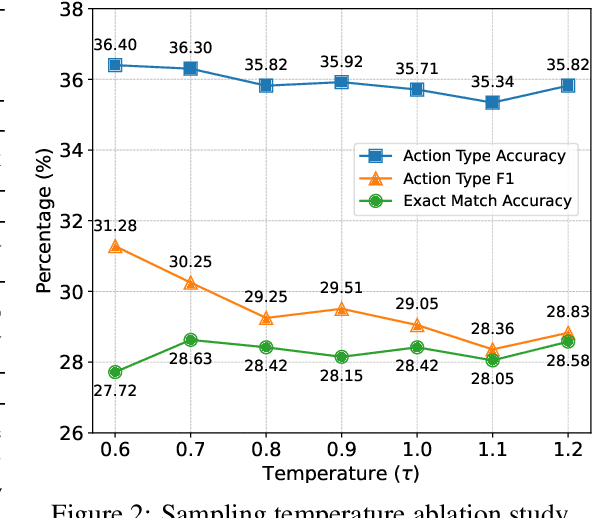

Abstract:Large Language Models (LLMs) have recently demonstrated strong potential in generating 'believable human-like' behavior in web environments. Prior work has explored augmenting training data with LLM-synthesized rationales and applying supervised fine-tuning (SFT) to enhance reasoning ability, which in turn can improve downstream action prediction. However, the performance of such approaches remains inherently bounded by the reasoning capabilities of the model used to generate the rationales. In this paper, we introduce Shop-R1, a novel reinforcement learning (RL) framework aimed at enhancing the reasoning ability of LLMs for simulation of real human behavior in online shopping environments Specifically, Shop-R1 decomposes the human behavior simulation task into two stages: rationale generation and action prediction, each guided by distinct reward signals. For rationale generation, we leverage internal model signals (e.g., logit distributions) to guide the reasoning process in a self-supervised manner. For action prediction, we propose a hierarchical reward structure with difficulty-aware scaling to prevent reward hacking and enable fine-grained reward assignment. This design evaluates both high-level action types and the correctness of fine-grained sub-action details (attributes and values), rewarding outputs proportionally to their difficulty. Experimental results show that our method achieves a relative improvement of over 65% compared to the baseline.
Training LLMs for EHR-Based Reasoning Tasks via Reinforcement Learning
May 30, 2025Abstract:We present EHRMIND, a practical recipe for adapting large language models (LLMs) to complex clinical reasoning tasks using reinforcement learning with verifiable rewards (RLVR). While RLVR has succeeded in mathematics and coding, its application to healthcare contexts presents unique challenges due to the specialized knowledge and reasoning required for electronic health record (EHR) interpretation. Our pilot study on the MEDCALC benchmark reveals two key failure modes: (1) misapplied knowledge, where models possess relevant medical knowledge but apply it incorrectly, and (2) missing knowledge, where models lack essential domain knowledge. To address these cases, EHRMIND applies a two-stage solution: a lightweight supervised fine-tuning (SFT) warm-up that injects missing domain knowledge, stabilizes subsequent training, and encourages structured, interpretable outputs; followed by RLVR, which reinforces outcome correctness and refines the model's decision-making. We demonstrate the effectiveness of our method across diverse clinical applications, including medical calculations (MEDCALC), patient-trial matching (TREC CLINICAL TRIALS), and disease diagnosis (EHRSHOT). EHRMIND delivers consistent gains in accuracy, interpretability, and cross-task generalization. These findings offer practical guidance for applying RLVR to enhance LLM capabilities in healthcare settings.
TrialPanorama: Database and Benchmark for Systematic Review and Design of Clinical Trials
May 22, 2025Abstract:Developing artificial intelligence (AI) for vertical domains requires a solid data foundation for both training and evaluation. In this work, we introduce TrialPanorama, a large-scale, structured database comprising 1,657,476 clinical trial records aggregated from 15 global sources. The database captures key aspects of trial design and execution, including trial setups, interventions, conditions, biomarkers, and outcomes, and links them to standard biomedical ontologies such as DrugBank and MedDRA. This structured and ontology-grounded design enables TrialPanorama to serve as a unified, extensible resource for a wide range of clinical trial tasks, including trial planning, design, and summarization. To demonstrate its utility, we derive a suite of benchmark tasks directly from the TrialPanorama database. The benchmark spans eight tasks across two categories: three for systematic review (study search, study screening, and evidence summarization) and five for trial design (arm design, eligibility criteria, endpoint selection, sample size estimation, and trial completion assessment). The experiments using five state-of-the-art large language models (LLMs) show that while general-purpose LLMs exhibit some zero-shot capability, their performance is still inadequate for high-stakes clinical trial workflows. We release TrialPanorama database and the benchmark to facilitate further research on AI for clinical trials.
s3: You Don't Need That Much Data to Train a Search Agent via RL
May 20, 2025Abstract:Retrieval-augmented generation (RAG) systems empower large language models (LLMs) to access external knowledge during inference. Recent advances have enabled LLMs to act as search agents via reinforcement learning (RL), improving information acquisition through multi-turn interactions with retrieval engines. However, existing approaches either optimize retrieval using search-only metrics (e.g., NDCG) that ignore downstream utility or fine-tune the entire LLM to jointly reason and retrieve-entangling retrieval with generation and limiting the real search utility and compatibility with frozen or proprietary models. In this work, we propose s3, a lightweight, model-agnostic framework that decouples the searcher from the generator and trains the searcher using a Gain Beyond RAG reward: the improvement in generation accuracy over naive RAG. s3 requires only 2.4k training samples to outperform baselines trained on over 70x more data, consistently delivering stronger downstream performance across six general QA and five medical QA benchmarks.
Rec-R1: Bridging Generative Large Language Models and User-Centric Recommendation Systems via Reinforcement Learning
Mar 31, 2025



Abstract:We propose Rec-R1, a general reinforcement learning framework that bridges large language models (LLMs) with recommendation systems through closed-loop optimization. Unlike prompting and supervised fine-tuning (SFT), Rec-R1 directly optimizes LLM generation using feedback from a fixed black-box recommendation model, without relying on synthetic SFT data from proprietary models such as GPT-4o. This avoids the substantial cost and effort required for data distillation. To verify the effectiveness of Rec-R1, we evaluate it on two representative tasks: product search and sequential recommendation. Experimental results demonstrate that Rec-R1 not only consistently outperforms prompting- and SFT-based methods, but also achieves significant gains over strong discriminative baselines, even when used with simple retrievers such as BM25. Moreover, Rec-R1 preserves the general-purpose capabilities of the LLM, unlike SFT, which often impairs instruction-following and reasoning. These findings suggest Rec-R1 as a promising foundation for continual task-specific adaptation without catastrophic forgetting.
Multi-Keypoint Affordance Representation for Functional Dexterous Grasping
Feb 27, 2025



Abstract:Functional dexterous grasping requires precise hand-object interaction, going beyond simple gripping. Existing affordance-based methods primarily predict coarse interaction regions and cannot directly constrain the grasping posture, leading to a disconnection between visual perception and manipulation. To address this issue, we propose a multi-keypoint affordance representation for functional dexterous grasping, which directly encodes task-driven grasp configurations by localizing functional contact points. Our method introduces Contact-guided Multi-Keypoint Affordance (CMKA), leveraging human grasping experience images for weak supervision combined with Large Vision Models for fine affordance feature extraction, achieving generalization while avoiding manual keypoint annotations. Additionally, we present a Keypoint-based Grasp matrix Transformation (KGT) method, ensuring spatial consistency between hand keypoints and object contact points, thus providing a direct link between visual perception and dexterous grasping actions. Experiments on public real-world FAH datasets, IsaacGym simulation, and challenging robotic tasks demonstrate that our method significantly improves affordance localization accuracy, grasp consistency, and generalization to unseen tools and tasks, bridging the gap between visual affordance learning and dexterous robotic manipulation. The source code and demo videos will be publicly available at https://github.com/PopeyePxx/MKA.
Learning by Analogy: Enhancing Few-Shot Prompting for Math Word Problem Solving with Computational Graph-Based Retrieval
Nov 25, 2024



Abstract:Large language models (LLMs) are known to struggle with complicated reasoning tasks such as math word problems (MWPs). In this paper, we present how analogy from similarly structured questions can improve LLMs' problem-solving capabilities for MWPs. Specifically, we rely on the retrieval of problems with similar computational graphs to the given question to serve as exemplars in the prompt, providing the correct reasoning path for the generation model to refer to. Empirical results across six math word problem datasets demonstrate the effectiveness of our proposed method, which achieves a significant improvement of up to 6.7 percent on average in absolute value, compared to baseline methods. These results highlight our method's potential in addressing the reasoning challenges in current LLMs.
Unleashing the Power of LLMs as Multi-Modal Encoders for Text and Graph-Structured Data
Oct 15, 2024



Abstract:Graph-structured information offers rich contextual information that can enhance language models by providing structured relationships and hierarchies, leading to more expressive embeddings for various applications such as retrieval, question answering, and classification. However, existing methods for integrating graph and text embeddings, often based on Multi-layer Perceptrons (MLPs) or shallow transformers, are limited in their ability to fully exploit the heterogeneous nature of these modalities. To overcome this, we propose Janus, a simple yet effective framework that leverages Large Language Models (LLMs) to jointly encode text and graph data. Specifically, Janus employs an MLP adapter to project graph embeddings into the same space as text embeddings, allowing the LLM to process both modalities jointly. Unlike prior work, we also introduce contrastive learning to align the graph and text spaces more effectively, thereby improving the quality of learned joint embeddings. Empirical results across six datasets spanning three tasks, knowledge graph-contextualized question answering, graph-text pair classification, and retrieval, demonstrate that Janus consistently outperforms existing baselines, achieving significant improvements across multiple datasets, with gains of up to 11.4% in QA tasks. These results highlight Janus's effectiveness in integrating graph and text data. Ablation studies further validate the effectiveness of our method.
DTCLMapper: Dual Temporal Consistent Learning for Vectorized HD Map Construction
May 09, 2024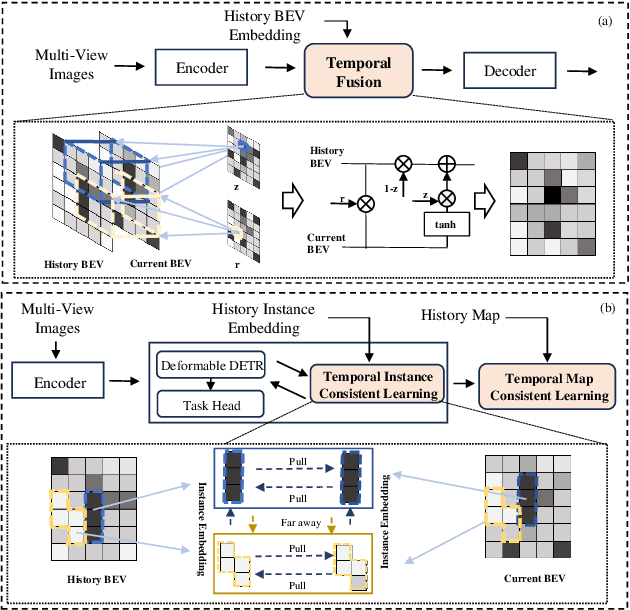
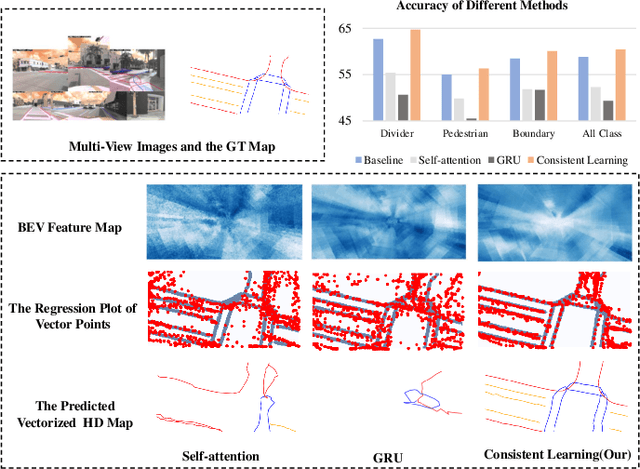
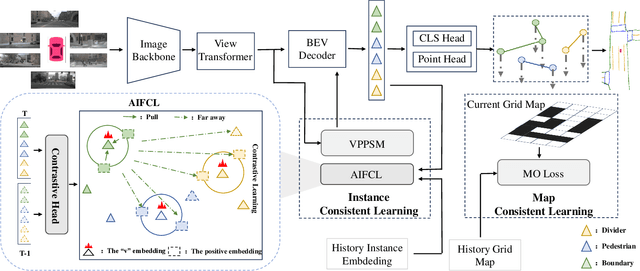
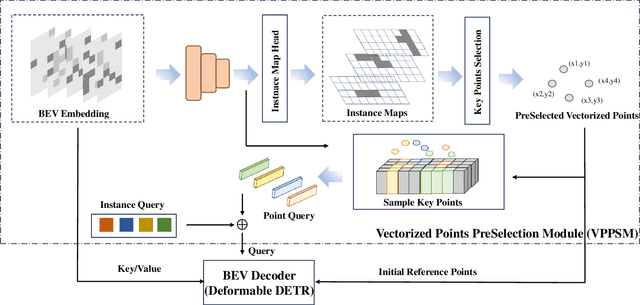
Abstract:Temporal information plays a pivotal role in Bird's-Eye-View (BEV) driving scene understanding, which can alleviate the visual information sparsity. However, the indiscriminate temporal fusion method will cause the barrier of feature redundancy when constructing vectorized High-Definition (HD) maps. In this paper, we revisit the temporal fusion of vectorized HD maps, focusing on temporal instance consistency and temporal map consistency learning. To improve the representation of instances in single-frame maps, we introduce a novel method, DTCLMapper. This approach uses a dual-stream temporal consistency learning module that combines instance embedding with geometry maps. In the instance embedding component, our approach integrates temporal Instance Consistency Learning (ICL), ensuring consistency from vector points and instance features aggregated from points. A vectorized points pre-selection module is employed to enhance the regression efficiency of vector points from each instance. Then aggregated instance features obtained from the vectorized points preselection module are grounded in contrastive learning to realize temporal consistency, where positive and negative samples are selected based on position and semantic information. The geometry mapping component introduces Map Consistency Learning (MCL) designed with self-supervised learning. The MCL enhances the generalization capability of our consistent learning approach by concentrating on the global location and distribution constraints of the instances. Extensive experiments on well-recognized benchmarks indicate that the proposed DTCLMapper achieves state-of-the-art performance in vectorized mapping tasks, reaching 61.9% and 65.1% mAP scores on the nuScenes and Argoverse datasets, respectively. The source code will be made publicly available at https://github.com/lynn-yu/DTCLMapper.
MambaMOS: LiDAR-based 3D Moving Object Segmentation with Motion-aware State Space Model
Apr 19, 2024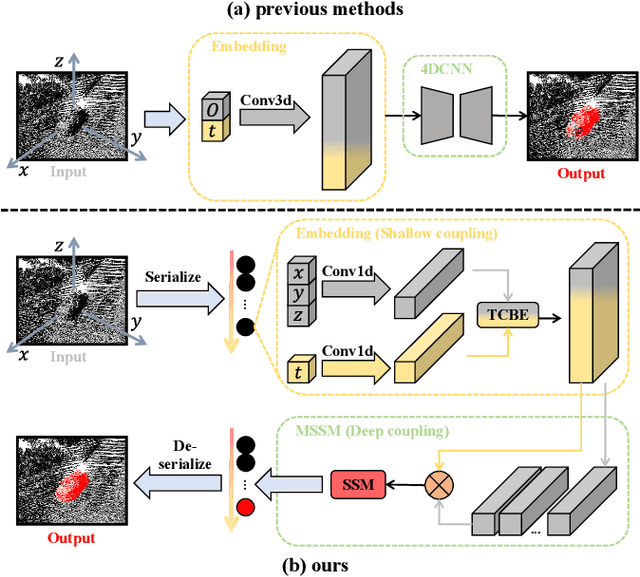
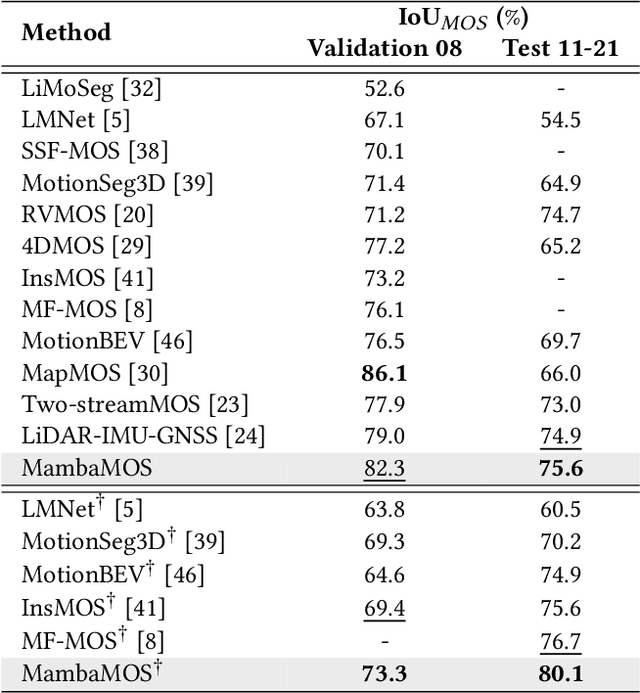
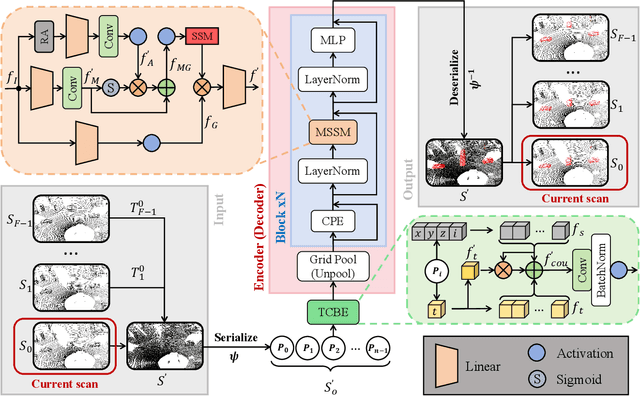

Abstract:LiDAR-based Moving Object Segmentation (MOS) aims to locate and segment moving objects in point clouds of the current scan using motion information from previous scans. Despite the promising results achieved by previous MOS methods, several key issues, such as the weak coupling of temporal and spatial information, still need further study. In this paper, we propose a novel LiDAR-based 3D Moving Object Segmentation with Motion-aware State Space Model, termed MambaMOS. Firstly, we develop a novel embedding module, the Time Clue Bootstrapping Embedding (TCBE), to enhance the coupling of temporal and spatial information in point clouds and alleviate the issue of overlooked temporal clues. Secondly, we introduce the Motion-aware State Space Model (MSSM) to endow the model with the capacity to understand the temporal correlations of the same object across different time steps. Specifically, MSSM emphasizes the motion states of the same object at different time steps through two distinct temporal modeling and correlation steps. We utilize an improved state space model to represent these motion differences, significantly modeling the motion states. Finally, extensive experiments on the SemanticKITTI-MOS and KITTI-Road benchmarks demonstrate that the proposed MambaMOS achieves state-of-the-art performance. The source code of this work will be made publicly available at https://github.com/Terminal-K/MambaMOS.
 Add to Chrome
Add to Chrome Add to Firefox
Add to Firefox Add to Edge
Add to Edge